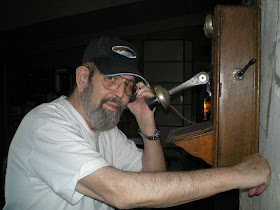Extrusions of every type are common stuff in airplanes but many homebuilders may not be aware of the fact the extruded shape usually receives additional forming. Extruded angle, for example, may be opened or closed by as much as twenty degrees (depending on the alloy). It is also common practice to alter the width of the flanges by milling or sawing, cutting them to a taper or machining them to accept stringers or other fittings. The thickness of an extrusion may also be altered to produce joggles or indentations needed to accommodate other components. Extrusions may be formed into circles, ovals or round-cornered rectangles and used as the frames for ports, hatches and so forth. When the flange is on the inside of the curve the extrusion is usually drilled & slotted to accommodate the bend, which is then reenforced with a doubler or scab plate. But when the flange is on the outside of the curve it may be bent to the required shape by hammering alone.
Re-forming an extrusion differs only slightly from every other type of forming operation. For serial production the manufacturer will usually design tooling using rollers or dies to do the re-forming so the required number of parts can be produced accurately and quickly without calling on a skilled metalsmith. But for one-offs, such as a homebuilt, the work is usually done by hand using mallets of wood, rawhide or lead, as appropriate, bapping the angle over a maple vee-block to form curves, over a polished cylindrical anvil to open the angle or simply tapping directly on the flanges to close them (or to form an angle that tapers along the length of the member). For homebuilts, tapering an extrusion is usually done with a table saw and most milling operations are accomplished with files.
The fact an extrusion arrives at the plant (or in your driveway) a quarter of an inch thick with two inch flanges and a perfect ninety degree angle between them does not mean it has to stay that way. The extrusion is simply a convenient starting point for whatever shape the design happens to require. This sort of thing is a normal part of building metal airplanes and because of it, is seldom mentioned specifically in manuals devoted to aviation metalsmithing although most include illustrations of the various procedures used to reform extrusions.
I've taken the trouble to post this message after a confused and rather funny exchange with a fellow building a Teenie Two, which uses extrusions for a number of components. On the wing spars the extrusions are filed, milled or routed so as to nest with the shear-web in a manner similar to the method used on the Spitfire and which the builder had no trouble understanding. But at the firewall the extrusions must be reformed to match angles dictated by the shape of the fuselage and the builder was not aware that it's perfectly legal to reform the extrusion by bending, so long as the resulting angle does not violate the malleability nor the temper of the stock being used. He also knew about slotting the inner flange to facilitate the formation of an inward bend. The funny part of the exchange was my assumption the fellow knew about bapping extrusions into whatever shape is required for an
outward bend, which does not require slotting. With that assumption as the foundation, his question about making the required angles caused me to think he was using an anvil of the wrong radius or simply wasn't hitting the thing hard enough, so I'm telling him to use a bar of smaller diameter, a heavier hammer or to hit it harder, convincing him I was a total loon when it came to tin-bending :-)
Calvin Parker is an excellent metalsmith, as shown by the simple sophistication of his design. Unfortunately the techniques needed to produce those elegantly simple junctions of extruded angle are left as an exercise for the student.
If you've never re-formed an extrusion you might want to try making ring of the stuff. Basic tool is a hammer and a sturdy block of wood, slotted to accept the down-angle, with a generous vee under the area where the bending will occur. Put the work-piece on the block, tap (gently) near the junction of the flanges with a heavy mallet as if you were trying to drive the piece into the vee of the block and you will see the piece begin to curve. The required stretching of the material in the down-angle is then adjusted and made more regular by light hammering near the edge of the flange whilst supported on a steel block. The result is an artful curve which if done for the full length of the piece will produce a neat ring of extruded aluminum, as for the base of a nacelle or the frame of a window or hatch.
-R.S.Hoover



